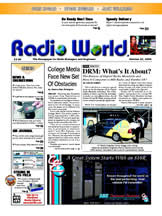
 |
|
|||||||||
|
|
 |
||||||||
 |
Solving the
Case of Tower vs. Tower by Mark Persons |
Radio
World Article March 14, 2011 |
|
March 15, 2011 e-mail: Mark, Just read your article about the wind turbine near KLOH. Good article, it is amazing how people don’t think about the fact that sticking large pieces of steel up in the air near a radio station antenna won’t have any effect. Steve in Richfield, Minnesota. March 8, 2011 e-mail: Mark, Nice article. Ben in Seattle, Washington. March 3, 2011 e-mail: Nice article on detuning the wind turbine pole in the March 1 Radio World that I just got today. Bob in Hamden, Connecticut. |
|
Mark Persons, W0MH, is certified by the Society of Broadcast Engineers as a Professional Broadcast Engineer and has more than 30 years experience. From the Radio World March 14, 2011 issue: http://www.radioworld.com/article/115310 See you down the road. I'll leave the soldering iron on for you. |
|
Questions? Email Mark Persons: teki@mwpersons.com |
|
.